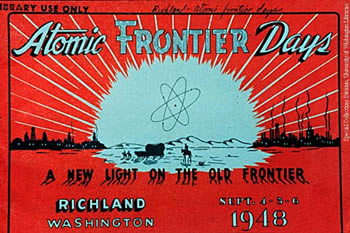 Lesson Twenty-four:
Lesson Twenty-four:
The Impact of the Cold War on Washington; Hanford, 1942-1992
Poster for 1948 Atomic Frontier Days (right). Richland High School Bombers logo (below). (Logo courtesy Richland High School).
Cold War symbols pervade the state of Washington. The Space Needle and Pacific Science Center attest to the future-minded, high-tech, aerospace-oriented thinking around Puget Sound. During the late 1950s and early 1960s, Seattle learned to call itself "jet city," among other "aerospacey" things, as Boeing's increasing production defined the local economy. During the annual Seafair festival (which commemorated not space but Seattle's maritime heritage), the city hosted the Navy's squadron of Blue Angel performing jets as well as a variety of naval vessels.
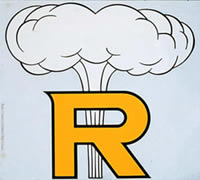
As devoted as Seattle was to Cold-War symbols, however, it could not match Richland, Washington, bedroom town for Hanford, in its identification with the Cold War. In Richland the atom, in an assortment of guises, became a very prominent icon. Residents could live on Proton Lane, bowl at the Atomic Lanes, and dine at Fission Chips. Townspeople referred to their community as Atomic City, A-City, or the Atomic City of the West (Oak Ridge, Tennessee, was the Atomic City of the East), and the city logo contained an image of the atom. During the 1950s Richland's annual summer festival—the equivalent of Seattle's Seafair—was called Atomic Frontier Days. When Richland teamed up with Pasco and Kennewick to form a chamber of commerce in the early 1960s, it was called the Tri-City Nuclear Industrial Council and it focused on attracting more atomic and space work in particular. Most notoriously of all, the Richland High Bombers, after 1970 or so, adopted an atomic-blast mushroom cloud as the school logo. Townspeople defended the much-criticized symbol as an accurate icon for their history. Much more than Seattle, Richland and Hanford, products of the atom, were creatures of World War Two and the Cold War. [On Richland's past see John M. Findlay, "Atomic Frontier Days: Richland, Washington, and the Modern American West," Journal of the West 34 (July 1995): 32-41.]
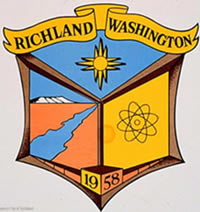
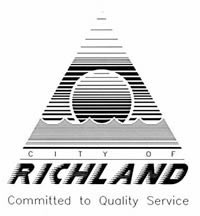 Richland city seal in 1958 (left). New Richland city seal (right). (Seals courtesy City of Richland)
Richland city seal in 1958 (left). New Richland city seal (right). (Seals courtesy City of Richland)
By the late 1990s, of course, the atom seemed less appealing than before. Hanford had ended its plutonium-producing career in 1987, the Tri-City Nuclear Industrial Council had renamed itself the Tri-City Industrial Development Council in 1985, and in 1990 Richland adopted a new city logo that did not include the atom. Communities after 1980 were less willing to be identified with the atom, in large part because nuclear power was now viewed as a quite problematic—perhaps even obsolete—technology that had presented serious public health and environmental risks and created enormous amounts of toxic and radioactive waste. When the Tri-Cities of the 1990s spoke about the technology of the future, they focused not on the atom but on the development of new methods for managing the wastes created during World War Two and the Cold War in the course of plutonium production. They generally did not regard nuclear wastes as a desirable icon for local towns (although they did see "remediation" of those wastes as an economic opportunity). Yet for many observers more distant from Hanford, the wastes were an all too enduring symbol of the history of Hanford and the Tri-Cities in the half-century after 1942.
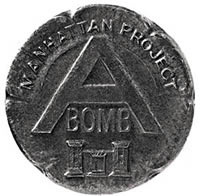 Manhattan Project Medal (right) (Courtesy U.S. Department of Energy).
Manhattan Project Medal (right) (Courtesy U.S. Department of Energy).
The nuclear facilities at Hanford were built up in separate phases between 1942 and 1982. The federal government took the lead in developing the site for the purpose of producing plutonium to use in nuclear weapons during and after World War II. Late in 1942 the Army selected the area to become part of the Manhattan Project, the crash campaign to build atomic bombs. In 1943 and 1944 the Army and its lead contractor, the DuPont company, built three production reactors and two processing buildings in which plutonium was purified. In later 1944 the first reactor started producing plutonium, and in 1945 Hanford began shipping its product to Los Alamos, New Mexico, whence the material was deployed as the fuel for the world's first atomic detonation (the Trinity test at Alamogordo, New Mexico, on July 16, 1945) and the second atomic bomb dropped on Japan (at Nagasaki) on August 9, 1945. (The bomb dropped on Hiroshima on August 6, 1945 was fueled by uranium produced at Oak Ridge.) Until bombs were dropped on Japan, virtually nobody knew what Hanford was for, and many Washingtonians grew quite suspicious of the secret site. After Hiroshima, however, the Army broke the news about the Manhattan Project in a carefully orchestrated public-relations effort. Thereafter, Washingtonians took pride in Hanford as one of their state's signal contributions to victory in World War II. [One introduction to wartime Hanford is S. L. Sanger, Hanford and the Bomb: An Oral History of World War II (Seattle:Living History Press, 1989). On wartime decisions about radioactive wastes, see Daniel Grossman, "Hanford and Its Early Radioactive Atmospheric Releases," Pacific Northwest Quarterly 85:1 (Jan. 1994): 6-14. The overall Hanford story is also contained in a rather triumphalist account by Michele Gerber, Legend and Legacy: Fifty Years of Defense Production at the Hanford Site (Richland, WA: U.S. Department of Energy Office of Environmental Restoration and Waste Management, 1992)]
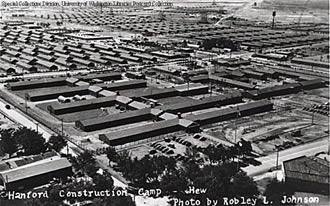
Hanford construction camp (left). (Special Collections, University of Washington, Nell Lewis MacGregor papers, box 1. Photo by Robley L. Johnson.)
The creation of a plutonium factory left an enormous footprint on south-central Washington. The workers building the plant, coming from all around the country, numbered as many as 45,000. Most departed by August of 1945, yet the population in the vicinity was substantially higher than it had been before the war. While building Hanford the Army and DuPont had also laid out the town of Richland to house the families of Hanford's operations employees during and after the war; the planned community had a population of around 15,000 at war's end. Other nearby towns, including Pasco and Kennewick, had also expanded considerably beyond their 1940 size. Yet in late 1945 and 1946 the outlook for Hanford remained uncertain as the United States debated the future of atomic weapons and its own role in world affairs. Residents of the Tri-Cities were not really certain that they could depend upon Hanford until 1947, when the federal government (now working through the newly created, civilian Atomic Energy Commission, or AEC) announced plans to expand Hanford by building more reactors there and accelerating the pace of production. In this second burst of growth, which lasted through 1955 or so, the site acquired five new plutonium-producing reactors and a host of new processing facilities. Hanford was the nation's main supplier of fissionable material for bombs as the Cold
| Population of Tri-Cities, 1940-1980 | |||||
|---|---|---|---|---|---|
| Year/City | 1940 | 1950 | 1960 | 1970 | 1980 |
| Pasco | 3,913 | 10,200 | 14,500 | 13,920 | 17,900 |
| Kennewick | 1,918 | 10,100 | 14,200 | 15,212 | 34,397 |
| Richland | 247 | 21,809 | 23,548 | 26,290 | 33,578 |
War began and the United States decided to rely heavily on its nuclear arsenal. The plant generated an ever-increasing amount of plutonium— as well as high levels of radioactive and chemical wastes, some of which were "stored" on the Hanford site and some of which were released to the atmosphere, the Columbia River, and surrounding lands. [One study of Hanford's environmental impact is Michele Stenehjem Gerber, On the Home Front: The Cold War Legacy of the Hanford Nuclear Site (Lincoln: University of Nebraska Press, 1992).]
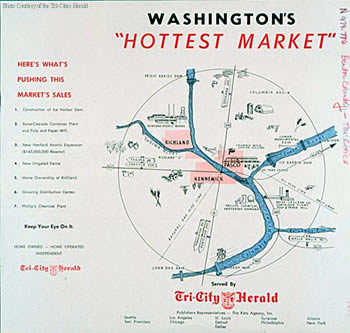
The Cold-War buildup at Hanford also increased the size of the growing metropolitan area known as the Tri-Cities. The development of a "local" population added an important ingredient to the politics of Hanford. Through the 1940s and 1950s, decisions by the federal government, made primarily in Washington, D.C., determined the fate of Hanford. And the federal government retained the predominant voice in the site's future through the 1960s, 1970s, and 1980s. If Uncle Sam wanted to build another reactor at Hanford or release more radioactivity into the surrounding environs, it generally saw no reason to consult the nearby population. One reason was the need for secrecy, for the AEC meant to avoid giving the Soviet Union any unnecessary chance to learn more about Hanford operations. However, in the 1950s the people residing in the vicinity of Hanford began pushing to have their voices heard, too. They worried in particular about the local economy, not the health risks presented by Hanford wastes. According to one estimate from the early 1960s, 80% of the 28,500 jobs in the Tri-Cities were "indirectly or directly dependent on Hanford activities." And Hanford, in contrast to Boeing, had not diversified its product line. It produced only for military and not civilian purposes.
Hanford Real Estate. Washington's "Hottest Market" in 1958. (Courtesy Tri-Cities Herald)
Worried that technological obsolescence or improved international relations could destroy their one-dimensional economy, residents of the Tri-Cities began pressing the AEC and Congress to diversify Hanford. Confident that nuclear power plants were the wave of the future, they lobbied the federal government to authorize construction of a ninth reactor at Hanford, one that could produce both plutonium for nuclear weapons and kilowatts for the BPA power grid. Senator Henry M. Jackson (D, WA) introduced a bill to this effect in 1956, and ten years later the dual-purpose N Reactor was completed at Hanford. While Washington, D.C., still called the truly important shots at Hanford, the people of Washington state began to feel that their voice could be heard, too, in planning Hanford's future. This became particularly important between 1964 and 1971, when the AEC shut down the first eight reactors built and operated at Hanford. The people in surrounding towns relied upon their new connections in Washington, D.C., especially Senators Jackson and Magnuson, to ensure that federal funds continued to flow toward Hanford, despite the shutdown of eight production reactors. The Tri-City economy managed to keep afloat until the 1970s, when construction of three nuclear power plants, under the auspices of the Washington Public Power Supply System (or WPPSS), got under way at Hanford (two others were started in western Washington). It seemed as if the region's economic future was assured. Indeed, Tri-City optimists glowingly envisioned the building of a "nuclear industrial park" with up to fifty different reactors producing plutonium and kilowatts as well as serving the cause of scientific research. Perhaps the Cold War would endure at Hanford in the form of productive reactors.
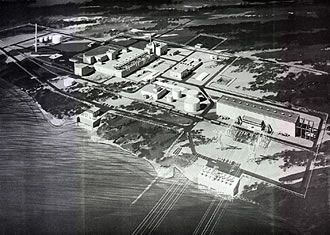
In April 1963, R. W. Beck and Asc. submitted to the Washington Public Power Supply System an engineering report covering the Hanford Electric Generating Project (left). This photograph is the artist's conception of what it would look like. (Reproduced in "Engineering Report: Hanford Electric Generating Project." Seattle, 1963, following title page. Photo credited to Burns & Roe)
These heady days were numbered. Always expecting to be on the cutting edge of nuclear technology, Tri-City residents were consistently disappointed by the twists and turns that the atomic age took. Construction of the three WPPSS reactors continued during the 1970s, fueling the local economy, but by 1982 it had become clear that nuclear power plants would not be an anchor for the future. Americans turned against nuclear power during the later 1970s and early 1980s. Moreover, the WPPSS reactors not only ran into enormous cost overruns but also were deemed increasingly unnecessary as forecasts for future demand for electricity were revised downward. Only one of the Hanford power reactors was actually finished—way behind schedule and over budget—and the Washington Public Power Supply System went broke. Hanford's economy kept going during the mid-1980s, spurred by President Reagan's defense build-up and by proposals to make storage of nuclear wastes from other sites an important part of the future. But these opportunities had closed by 1987, by which time plutonium production had ceased and decisions had been made not to import nuclear wastes from out of state. The economic future once more appeared bleak, with problems compounded by the fact that Senator Magnuson had failed to win re-election in 1980 and Senator Jackson died in 1983. The Tri-Cities had to face Hanford's future, and the end of the Cold War, without the cushion provided by Washington's powerful Democratic politicians.
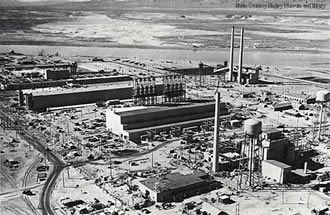
Reactor B at Hanford, 1943-44 (right). (Reproduced in Daniel Grossman, "Hanford and Its Early Radioactive Atmospheric Releases." Pacific Northwest Quarterly, Vol. 85, No. 1 [January 1994], p.13. Photo courtesy of Hagley Museum and Library.)
Since the mid-1960s, Hanford had been seeking a mission that would replace plutonium production as its reason for existence. It had failed to become a major center for nuclear power plants, nuclear research, or the importation of nuclear wastes. Being primarily an industrial plant throughout its career, it had never amassed the resources to become a major center for scientific innovation. And throughout the 1980s it had generally resisted suggestions that it make clean-up of its own wastes a high priority. "You can't overstate the demoralizing aspect of taking away high technology activities and asking us to become paper-pushers and janitors," one engineer explained. Yet despite the failure over twenty-five years to develop a new and compelling mission at Hanford, something always seemed to come along at the right time. In the late 1980s the Department of Energy (or DOE), which had emerged in 1977 as successor to the AEC, decided to make a huge commitment to cleaning up the wastes at its nuclear sites. (At roughly the same time, it began releasing previously classified documents that detailed the great extent of pollution in earlier years.) In 1989 the DOE, in a deal struck with the Washington state Department of Ecology and the U.S. Environmental Protection Agency, promised to invest a whopping $57 billion over the next thirty years in cleaning up and managing Hanford's waste—which represented about two-thirds of all wastes created by America's nuclear-weapons program since World War Two. By 1992 employment at the Hanford reservation reached an all-time high. The money and manpower applied to the waste problem at Hanford did not initially produce encouraging results, and there were charges of gross inefficiency, excess spending, and inadequate technology. Yet the economy of Hanford and the Tri-Cities (if not the environmental quality) again seemed secure, fifty years after the atomic age, and forty-five years after the Cold War, had arrived in Washington.
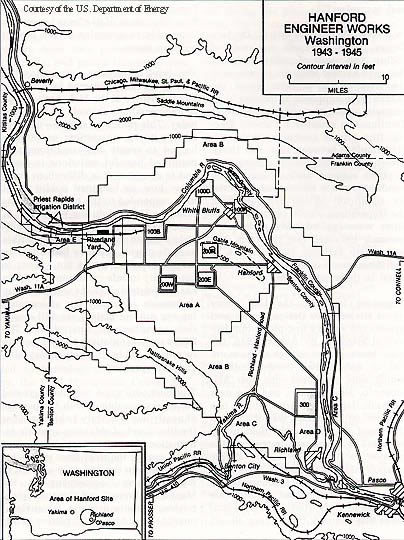
As the Tri-Cities looked to the future, they gave new attention to the Columbia River. The construction of Hanford during the 1940s and 1950s had impinged upon plans for the nearby lands and river which, in New-Deal plans for the Columbia Basin Project, had been earmarked for development through irrigation and hydroelectricity. Engineers and scientists designed the plutonium-producing reactors so that they were cooled by water pumped from and returned to the Columbia; thus the river carried radioactive wastes to the ocean, and needed to run free. Moreover, placement of Hanford along the mid-Columbia had prevented construction of Ben Franklin Dam (named for Benton and Franklin counties), proposed for a site just upstream from Richland. So long as nuclear wastes were stored in tanks and soils beneath the Hanford reservation, the dam could not be built because it would disturb the water table and the underground wastes, and flood sensitive portions of the Hanford reserve.
The paradoxical result was that the presence of the plutonium plant—which dispensed a considerable amount of radioactivity to the cold, clear water— prevented the damming of more than 50 miles of the river. The Hanford Reach thus became the last "free-flowing" stretch of the Columbia in Washington state upstream from Bonneville Dam. (By the 1990s, the idea of "free-flowing" had to be relative. Operation of the Priest Rapids Dam, just upstream from Hanford, causes the river to rise or fall as much as 10 feet over a fairly short time.) Contamination from Hanford may at times have created the most radioactive stream in North America, but the Hanford Reach also became one of the last great spawning beds for salmon in the United States. In 1989, according to one journalist, "as many as 90 percent of the approximately 530,000 fall chinook salmon harvested from the Columbia had been spawned in the Hanford Reach. More than 40,000 adults returned there to spawn [in 1993]—making it the healthiest spawning area on the Columbia." According to another journalist, "there are more chinook spawning per mile in the 51 miles of the [Hanford Reach] than anywhere else in the lower 48" (Portland Oregonian, Sept. 28, 1994; Tri-City Herald, Oct. 9, 1994).
Map of the Hanford Engineer Works, 1943-1945 (left). (Reproduced in Grossman, "Hanford," PNQ 85:1, p.8. Courtesy of the U.S. Department of Energy.)
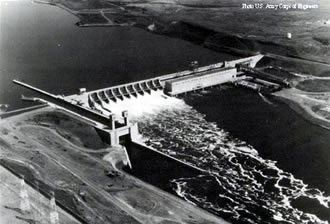
Ice Harbor Dam (right). (Reproduced in Keith C. Petersen,"Battle for Ice Harbor Dam: Fish, Navigation, and the Lower Snake River, 1948-1962." Pacific Northwest Quarterly 86:4 [Fall 1995], p.178. Photo courtesy of Walla Walla District, U.S. Army Corps of Engineers.)
The end of plutonium production at Hanford prompted new debate over what to do with the river. Some hoped to return to the vision, laid out most fully during the 1930s and early 1940s, of a stream harnessed to serve the economic needs of the region and the national-security needs of the nation. This vision had remained compelling in the mid-Columbia region after 1945, even though the construction and operation of the Hanford site compromised parts of it. The residents of Pasco, Kennewick, and Richland generally supported construction of dams on the Columbia and Snake rivers. [A good summary of the politics behind the construction of dams on the lower Snake is Keith C. Petersen, "Battle for Ice Harbor: Fish, Navigation, and the Lower Snake River, 1948-1962," Pacific Northwest Quarterly 86 (Fall 1995): 178-88. Petersen also wrote River of Life, Channel of Death: Fish and Dams on the Lower Snake (Lewiston, ID: Confluence Press, 1995).] No doubt encouraged by the presence of Hanford, Tri-City interests argued for dams on the grounds of military preparedness. Additional development of the river, of hydroelectric power, and of regional farm resources was essential if the Northwest was to contribute as much as it should to American mobilization for the Cold War. The nation needed "to develop every natural resource at its command," the Columbia Basin News opined. "The West is the last economic frontier. Its industrial and agricultural settlement is imperative" (Dec. 14, 1950). Advocates of dams expressed little concern for the ecological consequences. The Columbia Basin News (Feb. 28, 1951), in advocating construction of Ice Harbor Dam along the lower Snake, conceded that salmon runs would be injured but considered that a small price to pay:
"If the state is to be maintained as a glorified national park, then the desert will remain desert, and the productive potential must be discarded and forgotten. If full-scale industrial development is desired, it must be realized that civilization and the primitive are not compatible and some sacrifice of natural resources must be expected."
In some circles, this attitude toward use of rivers persisted into the 1980s. Indeed, with the shutdown of all but one Hanford reactor, the economic potential of the river loomed larger than before, and proposals for harnessing the Columbia further were resurrected. Some Tri-City boosters, along with the U.S. Army Corps of Engineers, urged that the Hanford Reach be dredged in order to permit barge traffic all the way upstream to Wenatchee, and promoted the building of Ben Franklin Dam in order to facilitate more irrigation, more generation of hydroelectricity, and more slack-water recreation. One Army Corps spokesperson explained, "We are in the business of building projects. And that's the last major dam site left on the river. However, we are having a little trouble selling that dam."
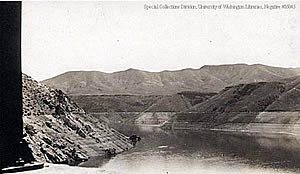
A view of Benton County (left) near the mouth of the Yakima River. (Special Collections, University of Washington, neg. #16045)
The Corps had trouble "selling that dam" because by the later 1980s and the 1990s American civilization, including most people in the Pacific Northwest, no longer had the same attitudes toward technology and the environment that they had held during World War Two and the height of the Cold War. Indeed, the troubles associated with the development of nuclear power had helped to spur the rethinking of those attitudes in the years after 1970. Nuclear weapons had helped the U.S. bring an end to World War Two and stand firm against the Soviet Union during the Cold War, but they had also exacted a very high environmental cost with which Americans became more preoccupied. In light of the harm done by dams to fisheries along the Columbia, or by radioactive releases from Hanford to nearby ecosystems, there emerged among people in the Pacific Northwest a sense that efforts to industrialize and militarize the Columbia had been somewhat shortsighted, even a little arrogant, in their confidence in the blessings that science and industry could wring from nature. Thus during the 1980s and 1990s there appeared a forceful opposition to proposals for dredging or damming more of the Columbia. Most residents of the region (and maybe even of the Tri-Cities) likely supported the 1992 recommendations of the National Park Service that the Hanford Reach be designated a "federal wild-and-scenic river," to be managed by the U.S. Fish and Wildlife Service, and that an 86,000-acre national wildlife refuge be created abutting the northern and eastern banks of the Hanford Reach.
After more than five decades of harnessing the river by building dams and dredging its bottom, of using it to cool atomic reactors and carry away radioactive wastes, it increasingly seemed like a good idea to try to leave the Columbia alone. The atomic age had yielded, perhaps, to the environmental era in the Pacific Northwest. Yet the effects of the Cold War on the region lingered on, both in the mind and on the land and waters.
| Course Home | Previous Lesson | Next Lesson |